Seminar on the Evidence of Manuscripts (September 1994)
August 30, 2016 in Manuscript Studies, Seminars on Manuscript Evidence, Uncategorized
“Canterbury Manuscripts:
A Seminar”
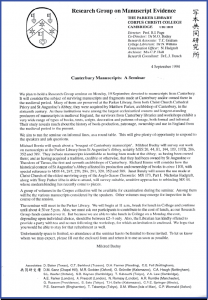 In the Series of Seminars on the Evidence of Manuscripts
In the Series of Seminars on the Evidence of Manuscripts
The Parker Library, Corpus Christi College, Cambridge
(16 December 1989)
Invitation in pdf.
The previous Seminar in the series considered
“Medieval Manuscript Fragments: Their Problems and Challenges”
Parker Library, August 1994
[First published on 30 August 2016]
Focused on the evidence and challenges of medieval manuscripts from Canterbury, this was the last Seminar in the Series on “The Evidence of Manuscripts” organized by the Research Group on Manuscript Evidence while the Group was still resident at The Parker Library of Corpus Christi College, Cambridge. September was the last month of the 5-year Leverhulme Trust Research Project based at the Library, with a team of specialists; the term of the Project extended from 1 October 1989 to 30 September 1994. The course and subjects of its research work are described in the detailed Annual Reports to the Leverhulme Trust. As described among our Publications, the Reports were reprinted and circulated, together with the current Profile (updated as appropriate) of the Research Group on Manuscript Evidence.
The specialist research work at the Library had, however, officially begun with the 2-year appointment (1987–1989) of an outside-funded full-time Senior Research Associate (Mildred Budny), dedicated to research on Anglo-Saxon and related manuscripts — emanating naturally from her comprehensive Ph.D. study of the Royal Bible of Saint Augustine’s Abbey, Canterbury, and applying its holistic methodology to relevant (as well as other) manuscripts at the Parker Library, including those undergoing conservation. Observing the value of such integrated dedication, photography included, to the study of manuscripts archaeologically revealed in disbinding and rebinding, the Librarian and the Senior Research Associate determined to apply to the Leverhulme Trust for outside funding both to continue and to extend this work, next with the full-time employment also of a Research Assistant (to be identified), as well as more photography of the unfolding evidence. The first Seminar in the Series of Seminars on “The Evidence of Manuscripts” took place several months before the Leverhulme Trust Research Project began, and considered “Manuscript Illustrations as Evidence for Anglo-Saxon Life”.
![© The British Library Board, Royal MS 10 A.XII, folio 2v. Miniature of Dunstan as a bishop, writing a commentary of the Rule of Saint Benedict, with an inscription 'S[an]c[tu]s Dunstanus'. Reproduced by permission](http://manuscriptevidence.org/wpme/wp-content/uploads/2016/08/K90098-50-222x300.jpg)
© The British Library Board, Royal MS 10 A.XII, folio 2v: Saint Dunstan as Scribe. Reproduced by permission.
One more Seminar in the same Series took place at The Parker Library in June 1995 (see below), after the Research Group had completed its major long-term research project there, had moved its principal base to the United States, and had begun its next series of scholarly events devoted to specific subjects of research on manuscripts and other written materials. Those series took the forms, in turn, of the Annual Symposia on “The Transmission of the Bible” (1995–2000) and then the “The New Series” (2001–) of Symposia, Colloquia, Workshops & Seminars.
In many ways, the swift and intense “First Series” of Seminars set the path (if not necessarily the pace, other conditions sometimes intervening) for the next steps, including scholarly events conducted mostly upon informal but structured lines, always constructively — as well as some forms of our Publications, including, on occasion, the Program Booklets. The first such Program Booklet emanated as a “Preliminary Report” from the Workshop on “Image-Processing and Manuscript Studies” in January 1994. Thus, the First Series contains many Firsts for the Research Group, including parts of our tradition of publishing, which lead, not least, to this very website. (You are Here.)
The Invitation Letter for the “Canterbury Manuscripts” Seminar (shown here and downloadable here with its RSVP form) states the case:
We plan to hold a Research Group seminar on Monday, 19 September, devoted to manuscripts from Canterbury. It will consider the subject of surviving manuscripts and fragments made at Canterbury and/or owned there in the medieval period. Many of them are preserved at the Parker Library, from both Christ Church Cathedral Priory and St Augustine’s Abbey; they were acquired by Matthew Parker, archbishop of Canterbury, in the sixteenth century. As these institutions were among the largest ecclesiastical owners and longest-standing producers of manuscripts in medieval England, the survivors from Canterbury libraries and workshops exhibit a very wide range of types of books, texts, scripts, decoration and patterns of usage, both formal and informal. Their study reveals much about the history of book-production, patronage, ownership and use in England from the medieval period to the present.
As usual, the seminar was designed informally, “as a round table”, to “give plenty of opportunity to respond to the speakers and ask questions”.
From the location in Cambridge, we surveyed, at a distance of both time and place, some highlights of the surviving legacy of book-production at Canterbury in the early Middle Ages. From the surviving (mostly late-medieval) catalogues of the libraries of both Christ Church Priory and Saint Augustine’s Abbey, viewed against the surviving identified or identifiable books, or parts thereof, it is painfully clear that the ruins of the libraries’ former glories, fragmented and dispersed, all-too-closely resemble the mangled and poorly, destructively, excavated ruins of Saint Augustine’s Abbey itself.
Subjects for Consideration
The Invitation Letter described the plan, naming speakers and subjects, without formal titles as such. Even the order of presentations might, as not infrequently in the Series, vary somewhat from the order described, while others among the participants contribute to the proceedings as well. Whetting the appetite, the Letter named names and cited some Corpus manuscripts.
Michael Borrie will speak about a “bouquet of Canterbury manuscripts.”
Cover / Poster (minus the pasted-in-photograph from Corpus Christi College MS 286) for the exhibition of ‘Canterbury at Corpus’ held at the Parker Library in 1991.
Mildred Budny will survey our work on manuscripts at the Parker Library from St Augustine’s Abbey, notably MSS 20, 44, 81, 144, 189, 197B, 286, 352 and 389. They include manuscripts identifiable as having been made at the abbey; as having been owned there; and as having acquired a tradition, credible or otherwise, that they had been owned by St Augustine or Theodore of Tarsus, the first and seventh archbishops of Canterbury.
Richard Emms will consider how the historical context of St Augustine’s Abbey affected its production and ownership of books to circa 1100, with special reference to MSS 44, 267, 270, 286, 291, 320, 352 and 389.
Janet Bately will assess the use made at Christ Church of the oldest surviving copy of the Anglo-Saxon Chronicle: MS 173, Part I.
Nicholas Hadgraft, along with Tony Parker if he is able to attend, will survey suitable, sensitive approaches to rebinding MS 44, whose modern binding has recently come to pieces.
With a break for lunch in College, the Seminar was followed by a Party hosted by the Librarian, Nigel Wilkins, with Tea and Scones in his Fellow’s set in Old Court.
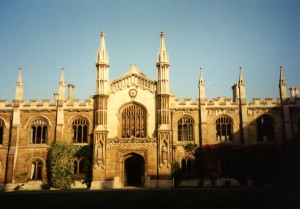
View Toward the Chapel at the Entrance to Corpus Christi College, Cambridge, in mid-September 1994. Photography © Mildred Budny
Speakers
The handwritten Report (or outlined “Minutes”) in the Research Group Archives (see below) indicates this sequence of presentations and observations on the day:
- Michael Borrie on changing approaches to illustration and decoration between the Anglo-Saxon and Norman periods as shown in Canterbury manuscripts now at The British Library
- Mildred Budny on identifying Canterbury manuscripts, partly through signs of use and reuse
- Nicholas Hadgraft on storage and bindings, old and new
- Michael Gullick on early Canterbury bindings (including Marshall MS 19 in Oxford and the Eadwine Psalter at Trinity College)
- Richard Emms on early Canterbury manuscripts and their historical contexts
- Joyce Hill on the work of known or recognised scribes, including Eadwine
- Mildred Budny (again) on identifying Canterbury manuscripts, partly through script, decoration, and illustration
- Janet Bately on the forms of additions, both Anglo-Saxon and later, displayed on the pages of MS 173, Part A, that is, MS “A” of the Anglo-Saxon Chronicle
- Tony Parker on the collagen repairs to MS 286, some forms of rebindings, and suggested solutions for the problems displayed by the burnt Cotton manuscripts now at the British Library
The Report cites the manuscripts which Michael Borrie discussed, via 35mm colour slides, at the British Library. The images shown here, thanks to the subsequent developments in digital imaging, the internet as an entity, and current policy at the British Library regarding the use of images from its collection, represent some of Michael’s choices. We thank him for taking the care to have slides prepared for presentation at the Seminar.
Manuscripts on View and under Consideration
On Site
The Letter proposes these manuscripts for examination from the Parker Library:
- MS 20 (Apocalypse, Visio Pauli, and Coronation Order, owned by Saint Augustine’s Abbey)
- MS 44 (The “Missal” of Saint Augustine’s Abbey)
- MS 81 (Works of Homer and Quintus Smyrnaeus in Greek, owned by Matthew Parker)
- MS 144 (Latin and Old English Glossaries, owned by Saint Augustine’s Abbey)
- MS 173, Part A (Parker Chronicle and Laws)
- MS 189 (Chronicle of Saint Augustine’s Abbey by William Thorne)
- MS 197, Part B (Corpus Portion of the Cambridge–London Gospels)
- MS 267 (Historiae, Part I, by Frechulf of Lisieux, made at Saint Augustine’s Abbey)
- MS 270 (The “Missal” of Saint Augustine’s Abbey)
- MS 286 (The 6th-Century Gospels of Saint Augustine of Canterbury, owned by Saint Augustine’s Abbey)
- MS 291 (Bede’s De temporum ratione and other computistical texts)
- MS 320 (Archbishop Theodore’s Penitential and Other Texts, owned by Saint Augustine’s Abbey)
- MS 352 (Boethius’ De institutione arithmetica, owned by Saint Augustine’s Abbey)
- MS 389 (The Vitae of Eremetical Saints by Saint Jerome and Felix, made and owned by Saint Augustine’s Abbey)
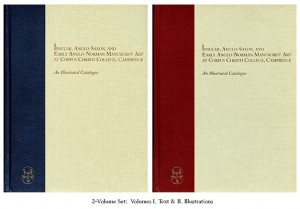 [Note: Some of these manuscripts figure in the Illustrated Catalogue (2 volumes, 1997) emanating from the long-term, integrated research work on selected Anglo-Saxon and related manuscripts at The Parker Library of Corpus Christi College, Cambridge. The stages of the research work are recorded, for example, in the Annual Reports to the Leverhulme Trust, described in our Publications. Many of the catalogue entries, as noted within them and the Introduction to the volumes, report the results of discoveries and discussions emerging in our series of Seminars, including this one on Canterbury Manuscripts.
[Note: Some of these manuscripts figure in the Illustrated Catalogue (2 volumes, 1997) emanating from the long-term, integrated research work on selected Anglo-Saxon and related manuscripts at The Parker Library of Corpus Christi College, Cambridge. The stages of the research work are recorded, for example, in the Annual Reports to the Leverhulme Trust, described in our Publications. Many of the catalogue entries, as noted within them and the Introduction to the volumes, report the results of discoveries and discussions emerging in our series of Seminars, including this one on Canterbury Manuscripts.
The manuscripts there are:
- MS 44 = Budny Number 46 (The Corpus Canterbury Pontifical)
- MS 144 = Budny Number 6 (The Corpus Glossary)
- MS 173, Part I = Budny Number 11 (Parker Chronicle and Laws)
- MS 197B = Budny Number 3 (The Cambridge Portion of the Cambridge–London Gospels)
- MS 267 = Budny Number 47 (Historiae, Part I, by Frechulf of Lisieux)
- MS 270 = Budny Number 48 (The “Missal” of Saint Augustine’s Abbey)
- MS 286 = Budny Number 1 (The Gospels of Saint Augustine of Canterbury)
- MS 291 = Budny Number 49 (Bede’s De temporum ratione and other computistical texts)
- MS 320, Part II = Budny Number 18 (Archbishop Theodore’s Penitential,
the Libellus Responsionum of Gregory the Great, and Other Texts) - MS 352 = Budny Number 20 (Boethius’s De Instituione Arithemetica)
- MS 389 = Budny Number 23 (The Vitae of Saints Paul and Guthlac by Saint Jerome and Felix)
On this publication and its continuing usefulness, see our Promotional Offer. ]
In Other Collections
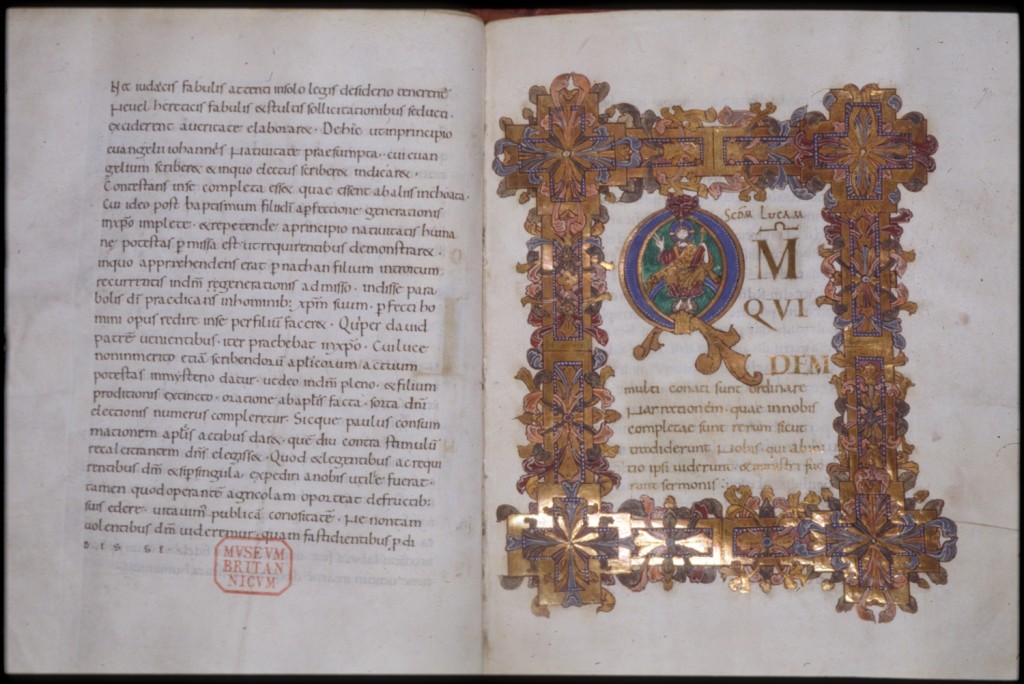
© The British Library Board, Royal MS 1 D IV, folios 69v-70r: Opening of the Luke Gospel. Reproduced by permission.
The British Library

© The British Library Board, Arundel MS 155, folio 133r: Saint Benedict and his Monks. Reproduced by permission.
Michael Borrie’s survey considered aspects of design in these manuscripts, and in this order:
- Harley MS 603
The Harley Psalter
Coloured outline drawings derived from the Utrecht Psalter - Royal MS 1 D. IX
Royal Gospels, or Gospels of King Cnut
Framed opening of the Gospel of Luke, with its elaborate trellis (shown above)
Arundel MS 155,
Saint Benedict and his Monks - Cotton MS Tiberius A iii
Regula Sancti Benedicti and Bilingual Regularis Concordia [originally in that order]
Their 2 frontispieces showing
Saint Benedict and his Monks and
The Authors and Audience of the Regularis Concordia
[This manuscript had formed the focus of our Seminar at the British Library in August 1993]
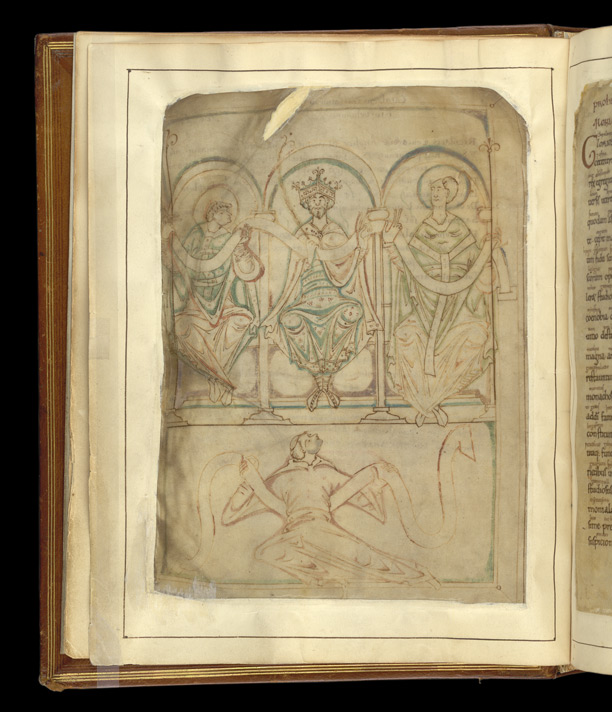
© The British Library Board, Cotton MS Tiberius A III, folio 2v: Authors of the ‘Regularis Concordia’ (Bishop Æthelwold, King Edgar, and Archbishop Dunstan) and their monastic Audience. Reproduced by permission.

© The British Library Board, Cotton MS Tiberius A III, folio 117v: Frontispiece to the ‘Rule of Saint Benedict’, with Benedict and his monks. Reproduced by permission.
- Cotton MS Caligula A. XV, Part II
Collection of computistical texts, tables, and more
Illustration of Saint Pachomius receiving the Easter Tables (folio 122v)
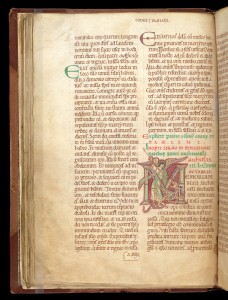
© The British Library Board, Arundel MS 91, folio 26v: Saint Michael and the Dragon in the Martyrology of Saint Augustine’s Abbey. Reproduced by permission.
- Arundel MS 91
Part of a 7-volume collection of Saints’ Lives
(in this volume, those for 21 September to 9 November)
Historiated initial depicting Saint Michael and the Dragon (folio 26v) - Cotton MS Vitellius C XII
The Martyrology of Saint Augustine’s Abbey
Historiated initial with the occupation of the month of February (folio 117v = Historiated Initial with Aquarius ) - Cotton MS Julius A. vi
Kalendar and Hymnal
Occupation of the Month of June (folio 5v): Pruning and gathering wood - Royal MS 10 A XIII
Expositio in Regulam Sancti Benedicti by Smaragdus of Saint Mihiel (copied at Christ Church, Canterbury, circa 1170–1180)
Frontispiece (shown at top here) depicting Saint Dunstan (circa 909 – 960)
enthroned at work on copying the text of the commentary on Benedict’s Rule
![© The British Library Board, Royal MS 10 A.XIII, folio 2v. Miniature of Dunstan as a bishop, writing a commentary of the Rule of Saint Benedict, with an inscription 'S[an]c[tu]s Dunstanus'. Reproduced by permission](http://manuscriptevidence.org/wpme/wp-content/uploads/2016/08/K90098-50-757x1024.jpg)
© The British Library Board, Royal MS 10 A.XIII, folio 2v. ‘S[an]c[tu]s Dunstanus’ (identified by beheaded inscription at the top), richly robed as archbishop, bends with quill and knife, and with inkwell at the ready on his draped table, to work on copying a commentary on the ‘Rule of Saint Benedict’, the text of which begins on the facing page. Reproduced by permission.
- Vespasian A I
The 8th-century Vespasian Psalter, made and owned by Saint Augustine’s Abbey,
with a continuous interlinear mid-9th-century Old English gloss entered on its pages by the Master Scribal Artist of the Royal Bible
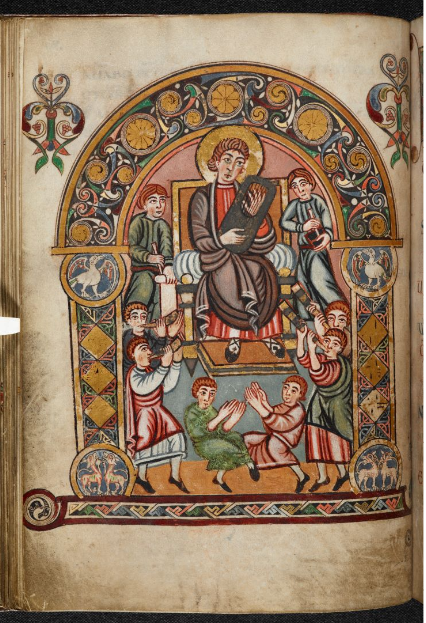
© The British Library Board, Cotton MS Vespasian A I, folio 30v: Frontispiece with King David the Psalmist and his Musicians and Dancers. Reproduced by permission.
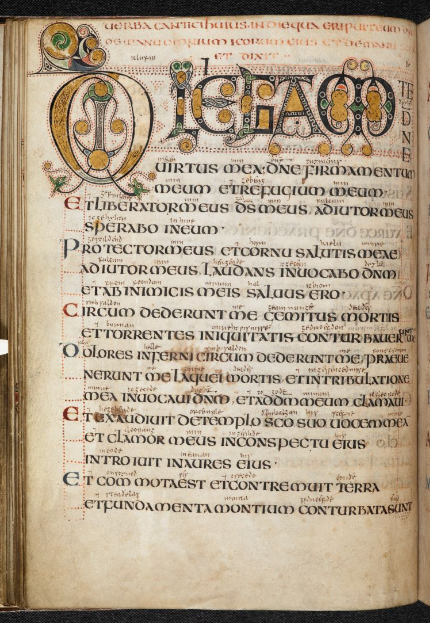
© The British Library Board, Cotton MS Vespasian A I, folio 21v, opening of Psalm 17. Reproduced by permission.
- Royal MS 1 E VI
The 9th-century Royal Bible, made and owned by Saint Augustine’s Abbey
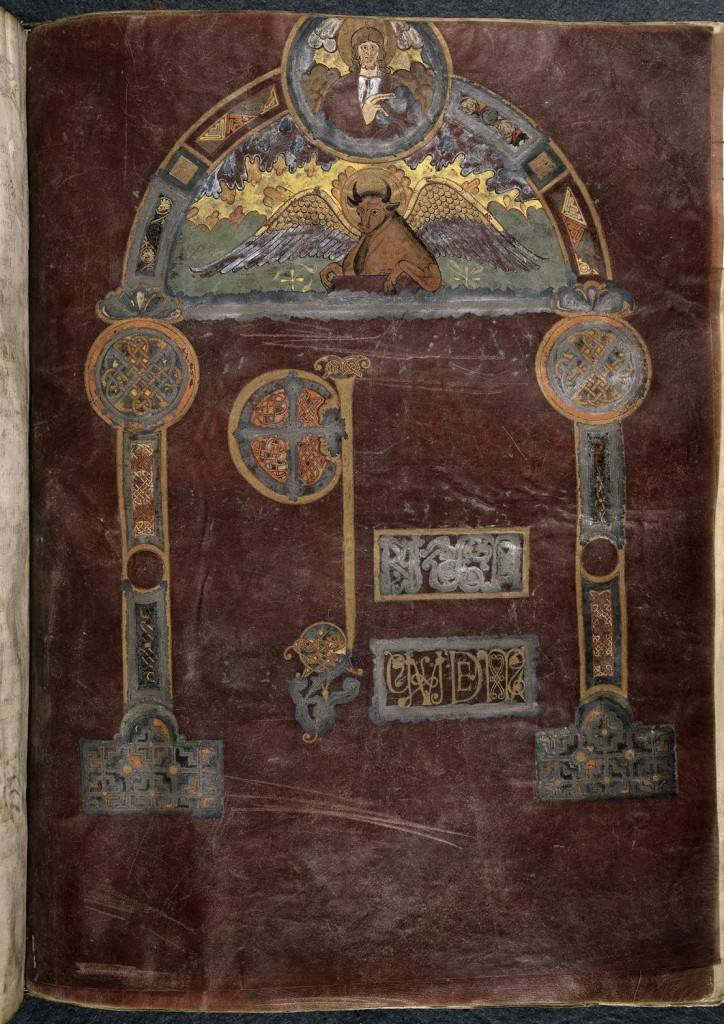
© British Library Board. Royal MS 1 E.VI, folio 43r: Opening of the Luke Gospel. Reproduced by permission.
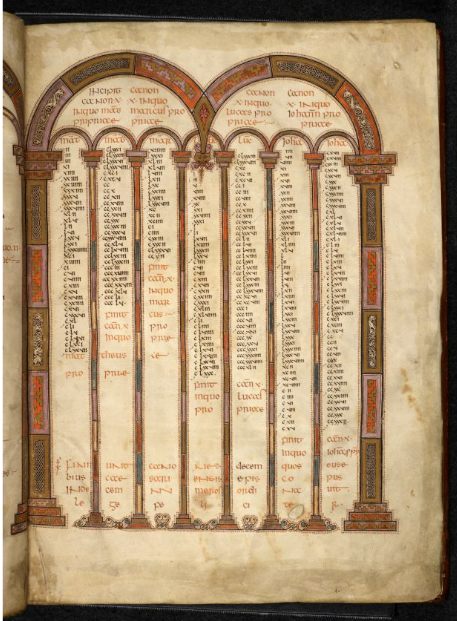
©The British Library Board, Royal MS 1 E vi, folio 6r: Last of 5 majestic full-page Canon Arcades for the Eusebian Canon Tables. Reproduced by permission.
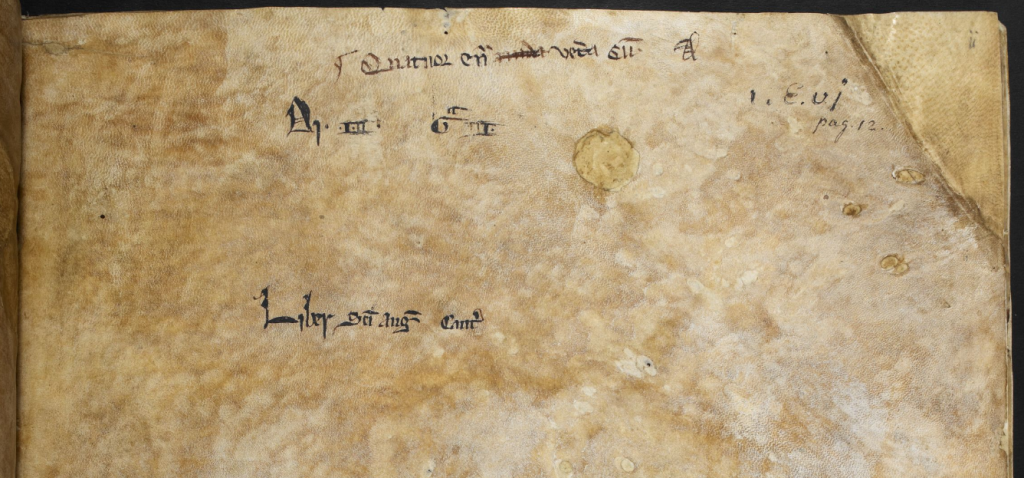
© The British Library Board, Royal MS 1 E vi, folio ii recto, top: Saint Augustine’s Abbey library inscriptions recording ownership, pressmark, and the already-despoiled state of the manuscript. Reproduced by permission.
[Note: Reflections upon the Royal Bible form the centerpiece for an early post (26 June 2015) in our blog on Manuscript Studies: The ‘Foundling Hospital’ for Manuscript Fragments.]
Elsewhere
Manuscripts in other collections came into consideration as well in the presentations and discussion, as noted in the summary above of the Report on the day.
*****
Report
An unnumbered and untitled 15-page handwritten report by Mildred Budny survives in the Research Group Archives. Comprising a form of notes on the day, this text outlines the sequence and contents of the presentations and their discussions, and cites the manuscripts in other libraries (the British Library and the Bodleian Library) mentioned for consideration or comparison. It allows points of confirmation, contrast, or amplification in the event as accomplished for the elements of intention recorded in the Invitation Letter.
*****

© The British Library Board, Arundel MS 155, folio 12r: Polychrome opening page of Psalm 1, embellished with gold and ornate trellis ornament, interlace included. Reproduced by permission.
Party
The Seminar was followed by a Party, with “Tea and Scones”, hosted by Nigel Wilkins (the Librarian) and Mildred Budny in Room P3 (Old Court).
Participants
Invitations sent to:
R.I. Page, Mildred Budny, Nigel Wilkins, Tim Graham, Leslie French, Catherine Hall, Nicholas Hadgraft, Tony Burne, E.A. Wrigley, Mel Jefferson, Richard Emms, Janet Bately, Jane Roberts, Simon Keynes, Joyce Hill, Don Scragg, Malcolm Godden, Michael Borrie, Stephanie Kenna, Andrew Prescott, Nigel Ramsay, Michelle Brown, Tony Parker, Richard Palmer, Melanie Barber, Margaret Sparks, Michael Stansfield, Tessa Webber, Richard Gameson, Michael Gullick, Vivien Law, Graham Caie, Joan Lazenby, Sue Hitch, Richard Marsden, Rohini Jayatilaka, Susan Kelly, Nicholas Brooks, Charles Burnett, Anne Oakley, Martin Brett
Present (according to the RSVP forms or absence thereof):
R.I. Page, Mildred Budny, Nigel Wilkins, Tim Graham, Leslie French, Catherine Hall, Nicholas Hadgraft, Tony Burne, E.A. Wrigley, Mel Jefferson, Richard Emms, Janet Bately, Jane Roberts, Simon Keynes, Joyce Hill, Malcolm Godden, Michael Borrie, Stephanie Kenna, Andrew Prescott, Tony Parker, Melanie Barber, Margaret Sparks, Michael Stansfield, Richard Gameson, Michael Gullick, Vivien Law, Graham Caie, Joan Lazenby, Richard Marsden, Susan Kelly, Nicholas Brooks, Charles Burnett, Martin Brett
*****
*****
Postscript and Round-Up:
The Several Series of Events
(Seminars, Workshops, Colloquia & Symposia)
of the Research Group on Manuscript Evidence
I. Seminars on the Evidence of Manuscripts (1989–1995)
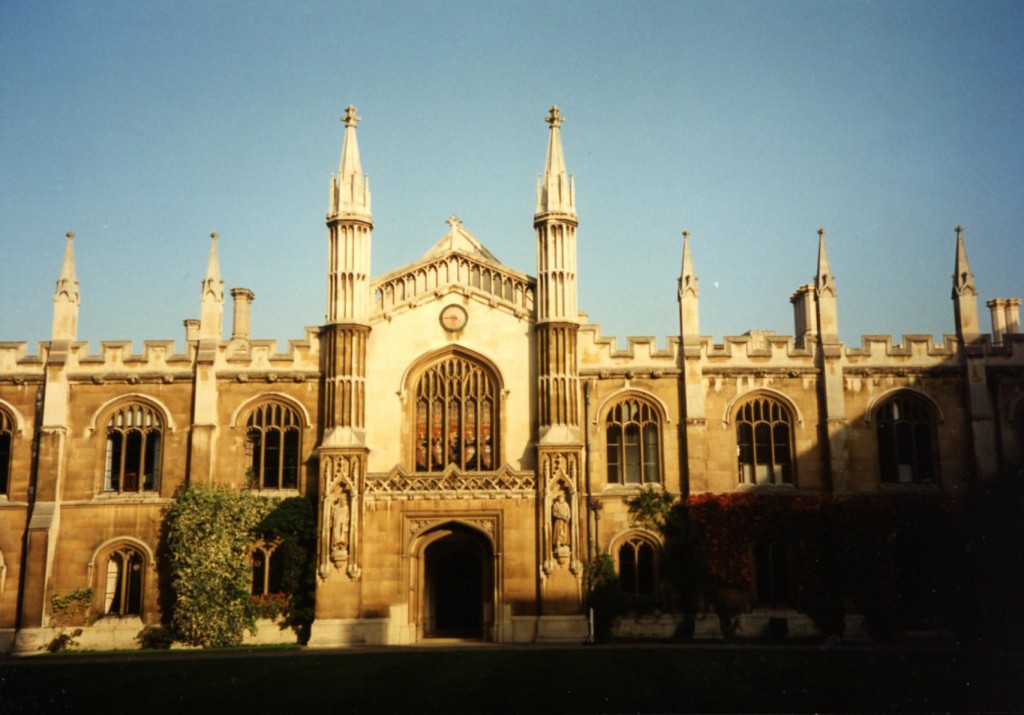
View with Afternoon Moon at the Entrance to Corpus Christi College, Cambridge, facing the Chapel, in mid-September 1994. Photography © Mildred Budny
This was the last Seminar in the Series while the Research Group on Manuscript Evidence was in residence at The Parker Library. Organized by Nigel Wilkins, the Librarian (and Associate of the Research Group on Manuscript Evidence), the next Seminar in the Series at the Library considered
Colour in Medieval Manuscripts
Parker Library, June 1995
II. The Next Series of Events
Events organized by the Research Group on Manuscript Evidence once its principal base had located in Princeton, New Jersey, in October 1994 focused on subjects which could be open to the public and did not depend mainly upon direct inspection of some manuscripts themselves.
The sequences of these subsequent events are reported within our Seminars, Workshops, Colloquia & Symposia overall. Like the First Series, those events wandered, or rotated, from center to center, as a veritable Moveable Feast. The events brought nourishing Food for Thought, with the contributions of scholars, students, and others, while the hosts and sponsors provided the Food and Drink to keep body and soul together, and the participants offered attention, feedback, and collegiality.
Generally, these subsequent events belong to two Series. The first Series centered upon a broad, but focused, topic: the Bible in its complex transmission across time and space, in words, images, rituals, culture, and many aspects of life. The next Series extended into other spheres of exploration, and additional materials, both manuscript and other, without leaving behind altogether the broad subject of the transmission of the Bible. In part this extension emerged through new contacts and collaborations found in, or through, the New World.
IIa. Symposia on “The Transmission of the Bible”
Thus commenced the series of Events organized by the Research Group on Manuscript Evidence in its new home in the New World. First was the Symposium on “The Bible and the Visual Arts” at Barnard College and Columbia University in New York City in April 1995.
This event launched the Series of Annual Symposia on “The Transmission of the Bible” (1995‒2000), held at different centers in turn. By chance (perhaps), its Series concluded with the Symposium on “Canterbury and the Bible”, held at Douglass College of Rutgers University in New Brunswick, New Jersey, in March 2000.
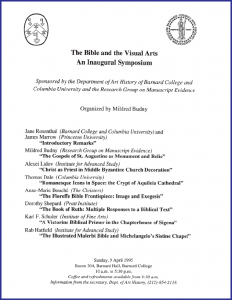
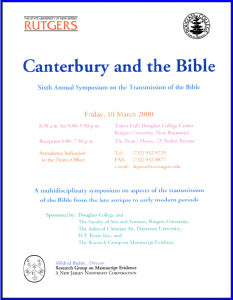 Just as the first Series of Seminars (and Workshops) on “The Evidence of Manuscripts settled onto a title not from the very first meeting, but rather as its meetings soon grew into a vibrant series, so, too, this next Series of Symposia on “The Transmission of the Bible” did not begin with a ready-set Series Title, as it began with a single Event on a specific subject — “The Bible and the Visual Arts”.
Just as the first Series of Seminars (and Workshops) on “The Evidence of Manuscripts settled onto a title not from the very first meeting, but rather as its meetings soon grew into a vibrant series, so, too, this next Series of Symposia on “The Transmission of the Bible” did not begin with a ready-set Series Title, as it began with a single Event on a specific subject — “The Bible and the Visual Arts”.
Soon, responding to its responses and the willingness by different centers to host its Events in turn, it grew into a steady Series with a selected focus. We did not exactly plan it that way; we approached each Event (as we still do) on its own, for its own merits, and in the context of our current and collective interests, contacts, projects, and opportunities.
IIb. “The New Series” of Symposia, Etc.
(Workshops, Colloquia, Seminars Included)
After that the completion of the Second Series of Symposia on “The Transmission of the Bible”, the Research Group concentrated on some other activities. They included:
- its Congress Activities at the Annual International Congress of Medieval Studies,
- its New Series of Symposia, Colloquia, Seminars, and related Events (2001–),
- the preparation and publication of its illustrated Bulletin ShelfLife,
- the development of its first website (launched in 2006),
- the pursuit of research projects of several kinds, often involving photographic work as well,
- the development, launch, and upgrades of its copyright multilingual digital font Bembino,
which you see on this website and which you might download and use FOR FREE, - the design, layout, and publication of more Publications,
including Posters and Program Booklets for its Events and Congress Sessions, - and more, as reported throughout this upgraded and illustrated version of our website (launched in 2014).
*****

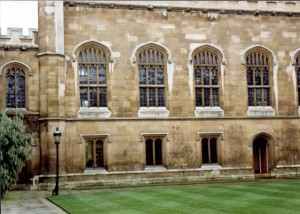
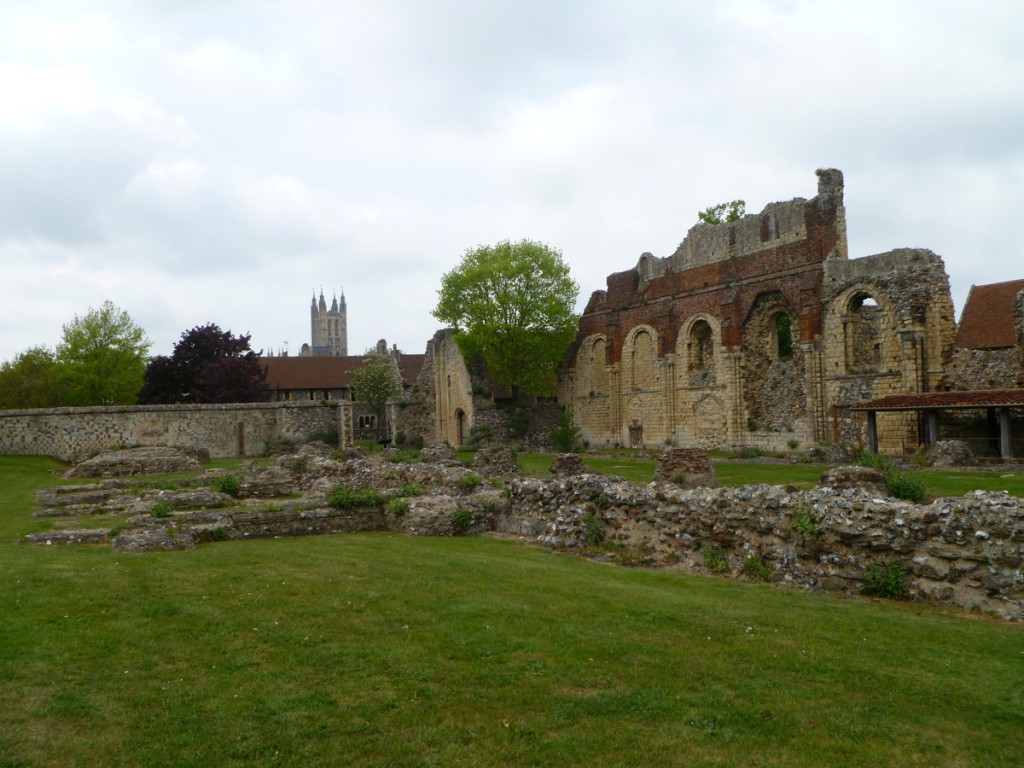





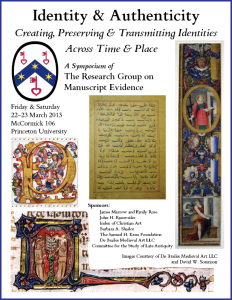
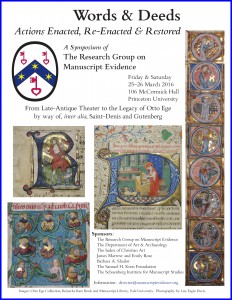
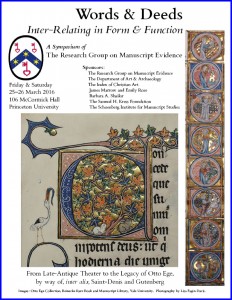
Wow this really takes me back, i’ve been thinking about this subject for a while.
Magnificent goods from you, man. I’ve keep in mind your
stuff prior to and you are just extremely fantastic. I actually like what you have got right here, certainly like what you’re saying and
the best way wherein you say it. You are making it entertaining and you still take care
of to keep it smart. I can not wait to learn much more from you.
This is really a great web site.
Unblocked recently posted…Unblocked